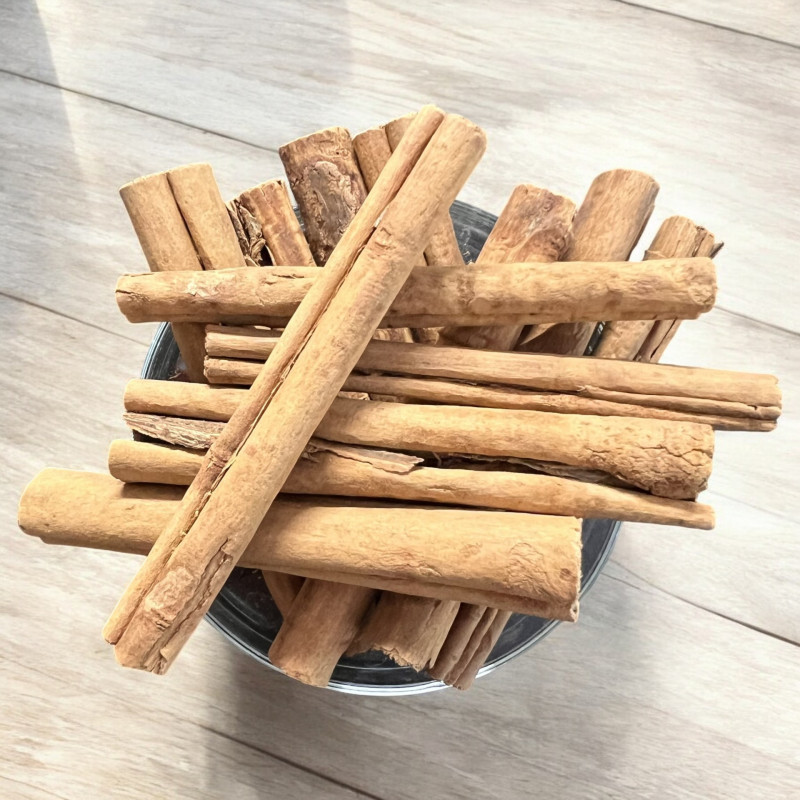
Reference: 00033929-0001


Its taste is smooth and sweet, with a warm, woody fragrance.
You'll enjoy using it in jams, tea, coffee, mulled wine, and spirits.
 Delivery
Delivery
Mondial Relay
 Returns
Returns
See conditions
 Payments
Payments
100% secure
Livré en sachet refermable
°°°
Uses in Cooking:
This is my favorite cinnamon! Its flavor is smooth, mild, sweet, and gives off a delightful aroma. When it's in stick form like this, it's best reserved for infusions (spirits, jams, tea, or coffee in small pieces). Since it's quite friable, it's easy to break into small chips, perfect for flavoring a single cup of tea or coffee.
In small pieces, it can also be mixed with other spices (cloves, cardamom, mace, rosebuds, whole ginger, etc.) and with tea (preferably black) to create a delicious spiced "chai tea." This tea is very mild and beautifully fragrant. Definitely worth trying! Moreover, the health benefits of the various spices in this mix make it excellent for your well-being!
In cooking, cinnamon pairs well with apples (in compotes and pies when ground), jams, chocolate, liqueurs, and spirits (mulled wine, hypocras, punch, spiced rum).
Cinnamon is also used in Oriental tagines (usually Indonesian cinnamon is used here, as it's more affordable), and in many Indian dishes.
It's also an essential part of the "five-spice" mix (Asian cuisine) and "four-spice" blend (for stuffings and pâtés).
Who am I?
Origin: Sri Lanka (formerly Ceylon)
Scientific name: Cinnamomum verum
This variety of cinnamon is one of the best in the world. The quality of cinnamon isn't measured by its length (which varies as it's usually cut into different-sized pieces), but by its structure, which should appear layered and friable, much like a cigar. Our cinnamon comes from the bark of the cinnamon tree originally grown in Ceylon, a species belonging to the Lauraceae family.
The unique flavor of cinnamon is due to the aromatic oil contained in the tree.
Ceylon cinnamon has the added advantage of containing almost no coumarin, a substance that can cause allergies in sensitive individuals.
Some studies suggest that cinnamon also has several interesting medicinal properties.
The part of the tree used (the cinnamon bark) corresponds to the thin inner layer of the bark. The scraping and rolling processes can only be done by hand, giving a sense of the labor involved in making each cinnamon stick!
A Little History:
Sri Lanka is an island nation located southeast of India, with a population of around 22 million people.
The country was previously known as Tambapanni by its first inhabitants, Taprobane by the Greeks, Serendip (or Serendib) by the Arabs, and later Ceylon until 1972.
The Chinese have been harvesting cinnamon for centuries. In ancient times, the Egyptians also used it in their embalming process. Today, cinnamon trees are grown in many warm regions worldwide.
Cinnamon only arrived in France around 1220. It was also a key ingredient in the famous medieval drink "hypocras."
Data sheet
 M. C.
M. C.
Tres bon

 M. C.
M. C.
Tres bon

Reference: 00033929-0001
Reference: paindepices
Reference: EPI230204
Reference: 7N7525705
Reference: 10N7738802
Reference: 6N7456401
Reference: ecorcecitronH
Reference: baiepassion
Reference: 108017302
Reference: 3913
Reference: SPW06600
Reference: 00033929-0001
Reference: badianeM
Reference: bergamote
Reference: cardamomeverteE
Reference: verveine
Reference: 1N7004306
Reference: 050721

Its taste is smooth and sweet, with a warm, woody fragrance.
You'll enjoy using it in jams, tea, coffee, mulled wine, and spirits.